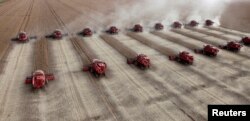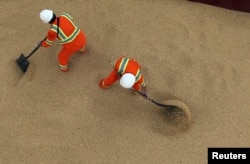Brazil is the largest exporter of soybeans, chicken and beef in the world. It is also a major producer of pork and corn.
The Reuters news agency says Brazil’s success is partly a result of low prices for farm land and permissive land-use policies.
Some farmers are leaving the Amazon, partly because of international concerns about the rainforest. Many are moving to an area in the center of the country, known as the Cerrado.
The Cerrado is about the same size as Mexico. It stretches from Brazil’s western border with Paraguay up to the northeast and the Atlantic Ocean. It is the largest flat, wooded grasslands in South America. The area is also home to five percent of living species on Earth.
Over the past 10 years, Brazilian farmers have been developing large parts of the Cerrado. The government says the area has lost more than 105,000 square kilometers of its native plant cover since 2008. That number represents 50 percent more land than the deforestation seen during the same period in the Amazon. Based on relative size, the Cerrado is disappearing nearly four times faster than the rainforest.
The Cerrado is also rich in carbon dioxide gas. Studies have linked rising levels of carbon dioxide to rising temperatures in Earth’s atmosphere. Many scientists blame the increase on deforestation and use of coal, oil and other fossil fuels.
Brazilian officials say protection of native plant life is important to meeting the country’s goals under the 2016 Paris Agreement on climate change. But scientists say industrial farming in the Carredo could hold back Brazil's efforts and worsen global warming.
Liliana Pena Naval is an environmental engineering professor at the Federal University of Tocantins. She told the Associated Press that the removal of plants can cause bodies of water to disappear.
Thousands of plants, fish, insects and animals are also affected. Many of these species are only beginning to be studied.
Farmers see the development of the Cerrado as necessary for Brazil’s food security and economic success. The agriculture industry grew 13 percent in 2017. The ability to keep producing new farmland at low costs has given Brazil better chances for success than other countries.
Increased trade with China
Deforestation in the Cerrado has slowed from the early 2000s. But farmers continue to develop large parts of the area. Much of the growth is fueled by Chinese demand for Brazilian meat and grain. China is Brazil's top buyer of soybeans. China is also a major purchaser of Brazilian pork, beef and chicken.
Rising trade tensions between China and the United States have only made the connection stronger. Brazil's soybean exports to China are up 18 percent through the first seven months of 2018. The increase comes as Chinese buyers have canceled tens of millions of dollars' worth of business deals with U.S. suppliers.
Environmental protections remain strong in Brazil. Rainforest farmers are required by law to protect 80 percent of native plants on their land. As part of its promise under the Paris Agreement, the government agreed to end illegal Amazon deforestation by 2030.
But Brazil has made no similar effort to protect the Cerrado. Environmentalists say the area’s wooded grasslands have failed to capture the public's attention the way the Amazon has.
Last year, some environmental protection groups began calling for large international businesses to protect the Cerrado. Among those groups were Greenpeace, the World Wildlife Foundation and the Brazilian research group IPAM. They called for immediate action to end the deforestation in a document known as the Cerrado Manifesto.
More than 60 companies, including McDonalds, Unilever and Walmart, offered to follow the manifesto. They have agreed to support measures that would end native vegetation loss in the Cerrado from their production processes.
Farmer Julimar Pansera purchased land in the Cerrado seven years ago. Today, he oversees nearly 49 square kilometers of soy fields and has about 20 full-time employees. He said there is no future without growth.
"There is still a large area to be opened," he said. "It will be one of the great centers of Brazilian agriculture."
I’m Jonathan Evans.
Jake Spring reported this story for the Reuters news agency. Jonathan Evans adapted his report for VOA Learning English. George Grow was the editor.
_________________________________________________________________
Words in This Story
deforestation – n. the act or result of cutting down or burning all the trees in an area
global warming – n. the recent increase in the world's temperature that is believed to be caused by the increase of certain gases such as carbon dioxide in the atmosphere
species – n. a group of animals or plants that are similar and can produce young animals or plants
vegetation – n. plants in general; plants that cover a particular area











